Redefining a flipped learning classroom: Using outside-classroom listening portfolio to boost inside-classroom speaking tasks
With the limited time in the classroom, many English language teachers have held a big
concern as to how to create more spaces, more time, and more opportunities for learners to use the target
language in a meaningful way. By using a qualitative method with different approaches of interviews,
document analysis, and classroom observations, this study aims at exploring the effect of adopting a
flipped learning model with the integration of listening and speaking on the development of these skills.
The study participants were 17 third-year English-major students enrolling in a listening-speaking 6
course at Quang Binh University. The findings showed that learners’ listening skills were significantly
improved and they appeared to be more confident and more productive when participating in insideclassroom speaking tasks with a well-prepared listening porfolio at home. The article drew an
implication that to boost learners’ independent learning and maximize the effect of the classroom time,
it is vital to apply homework-in-class and classwork-at-home model while integrating skills in language
education.
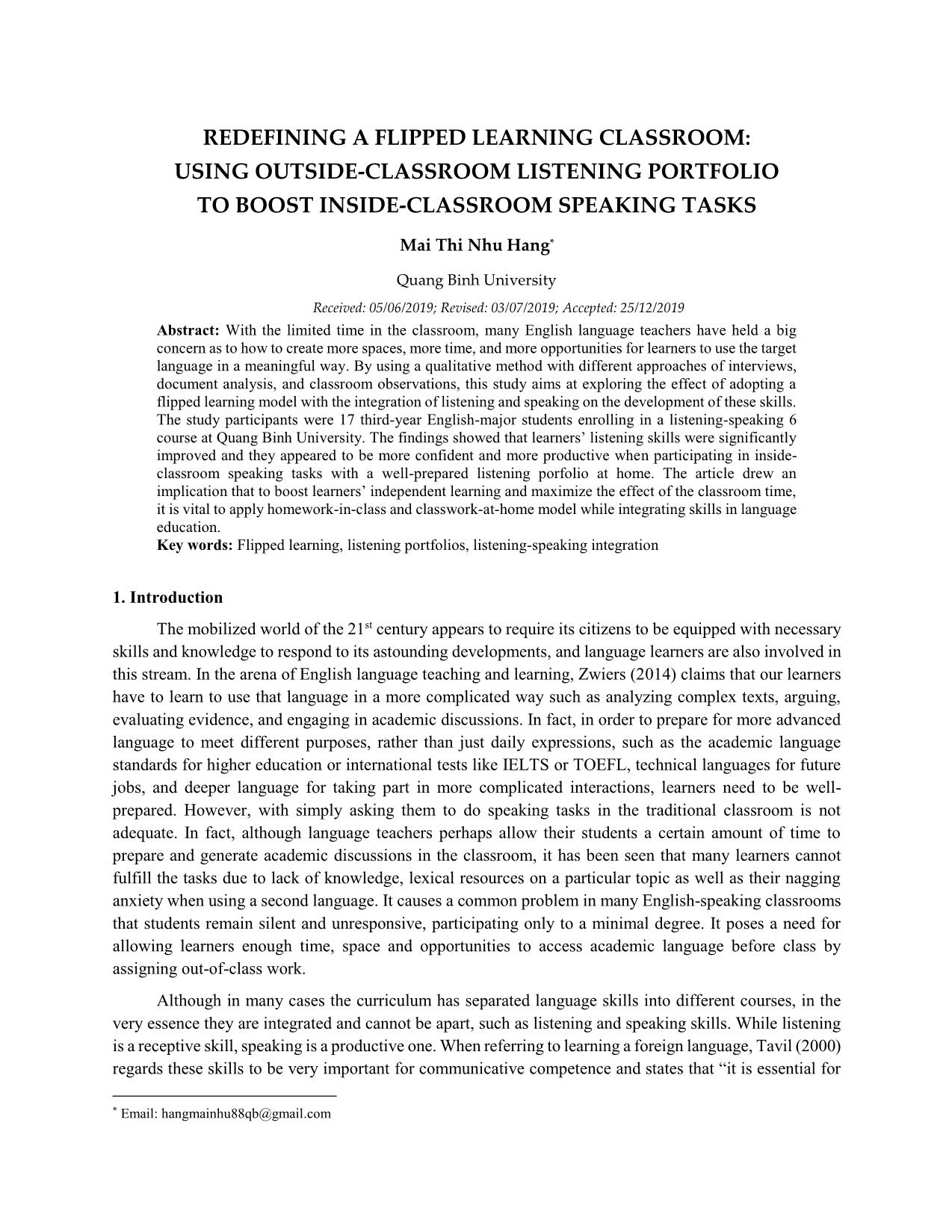
Trang 1
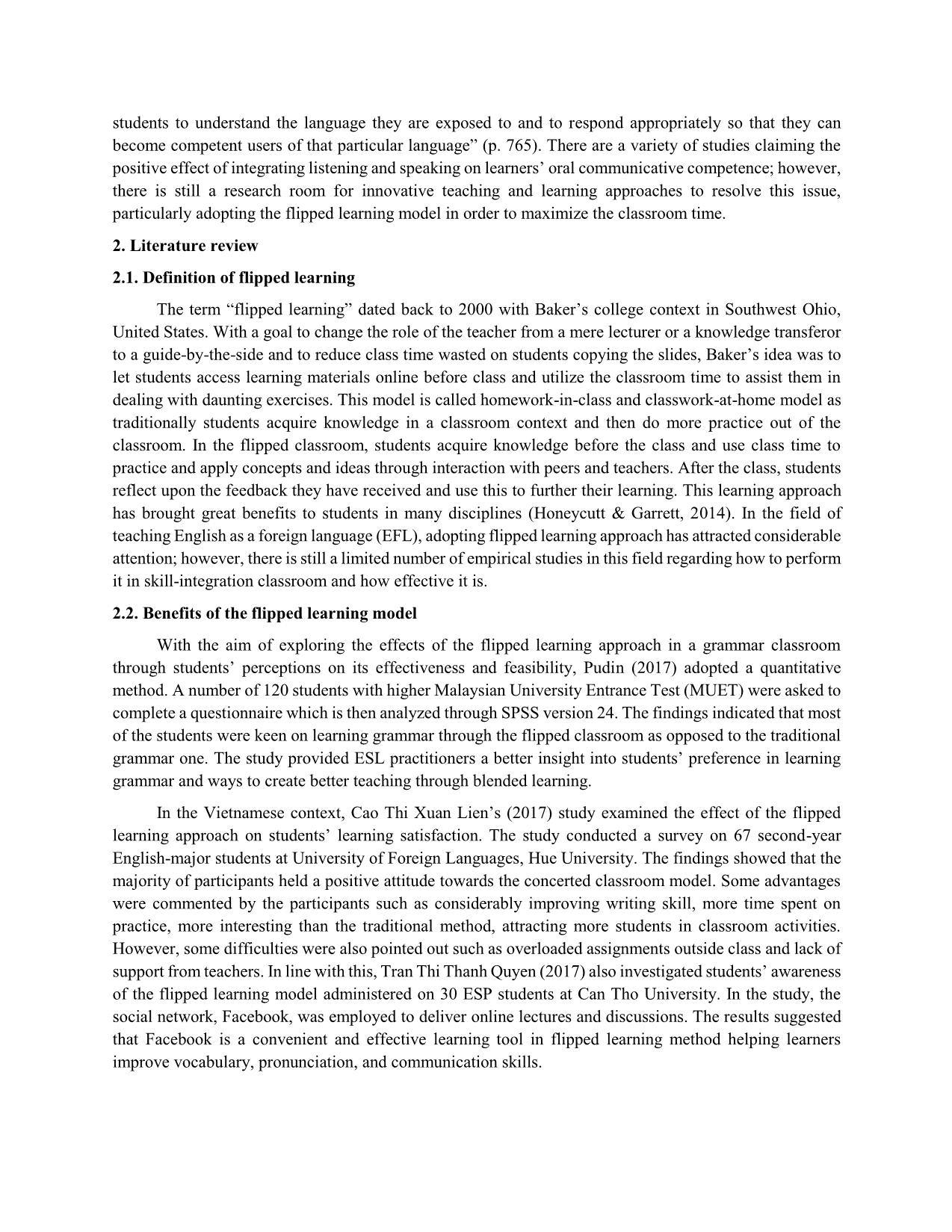
Trang 2
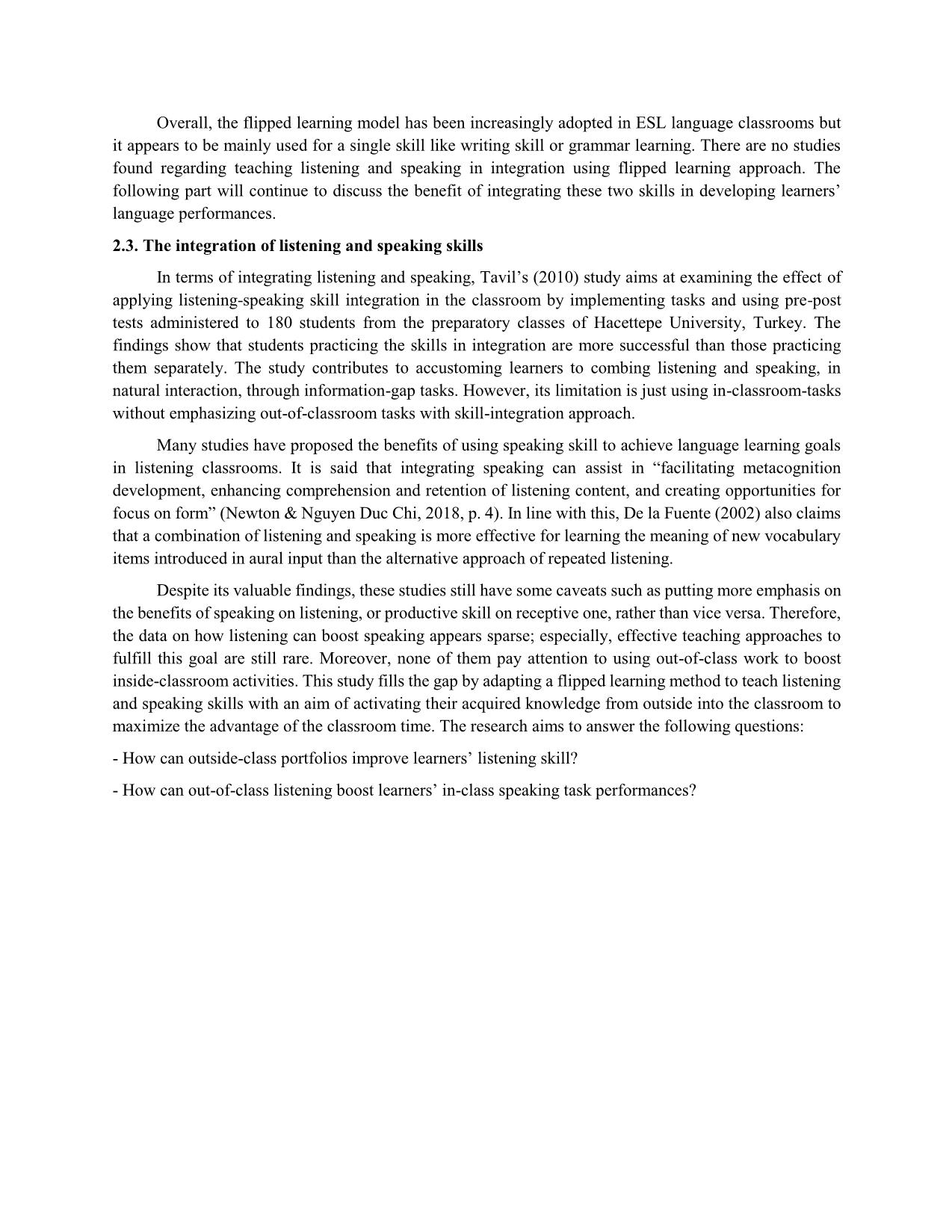
Trang 3
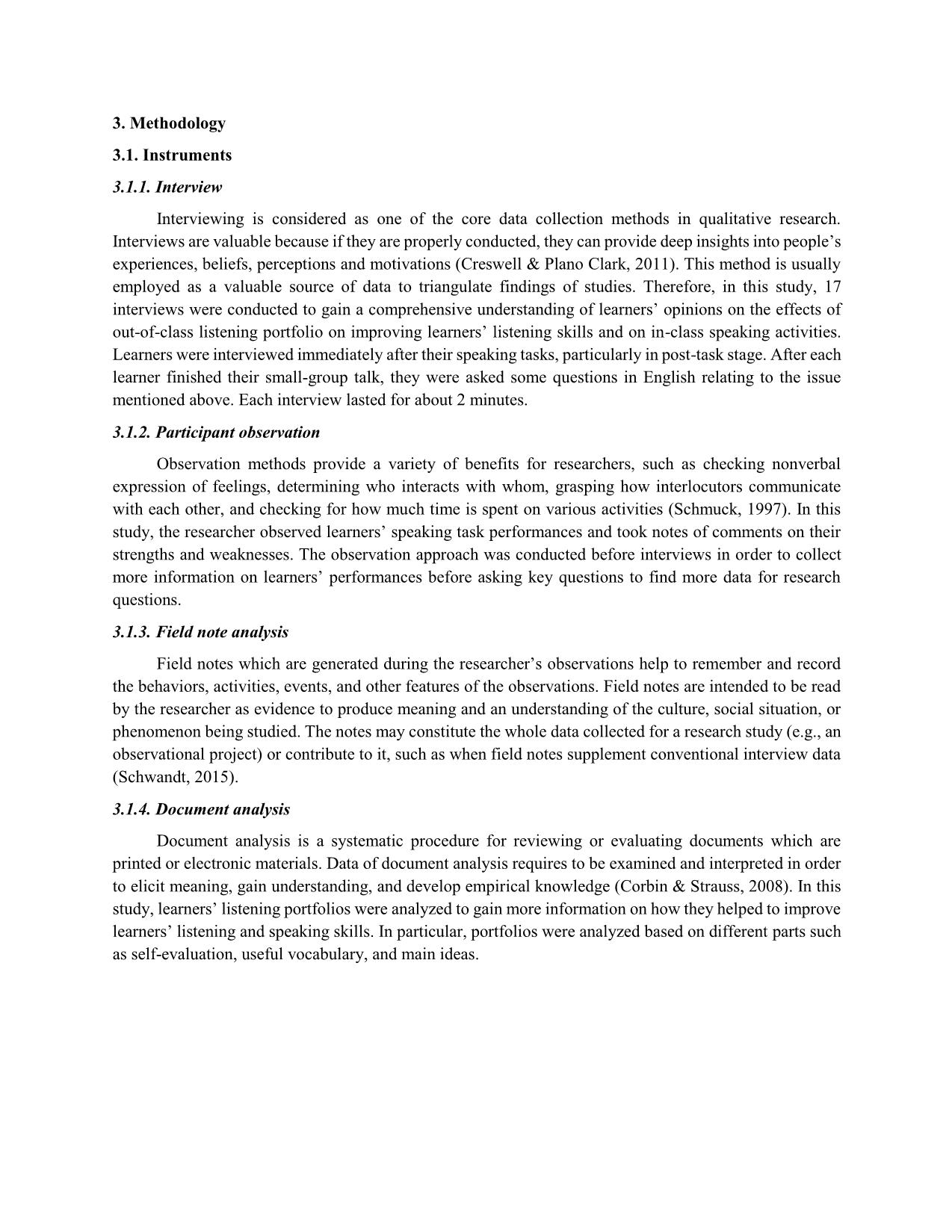
Trang 4
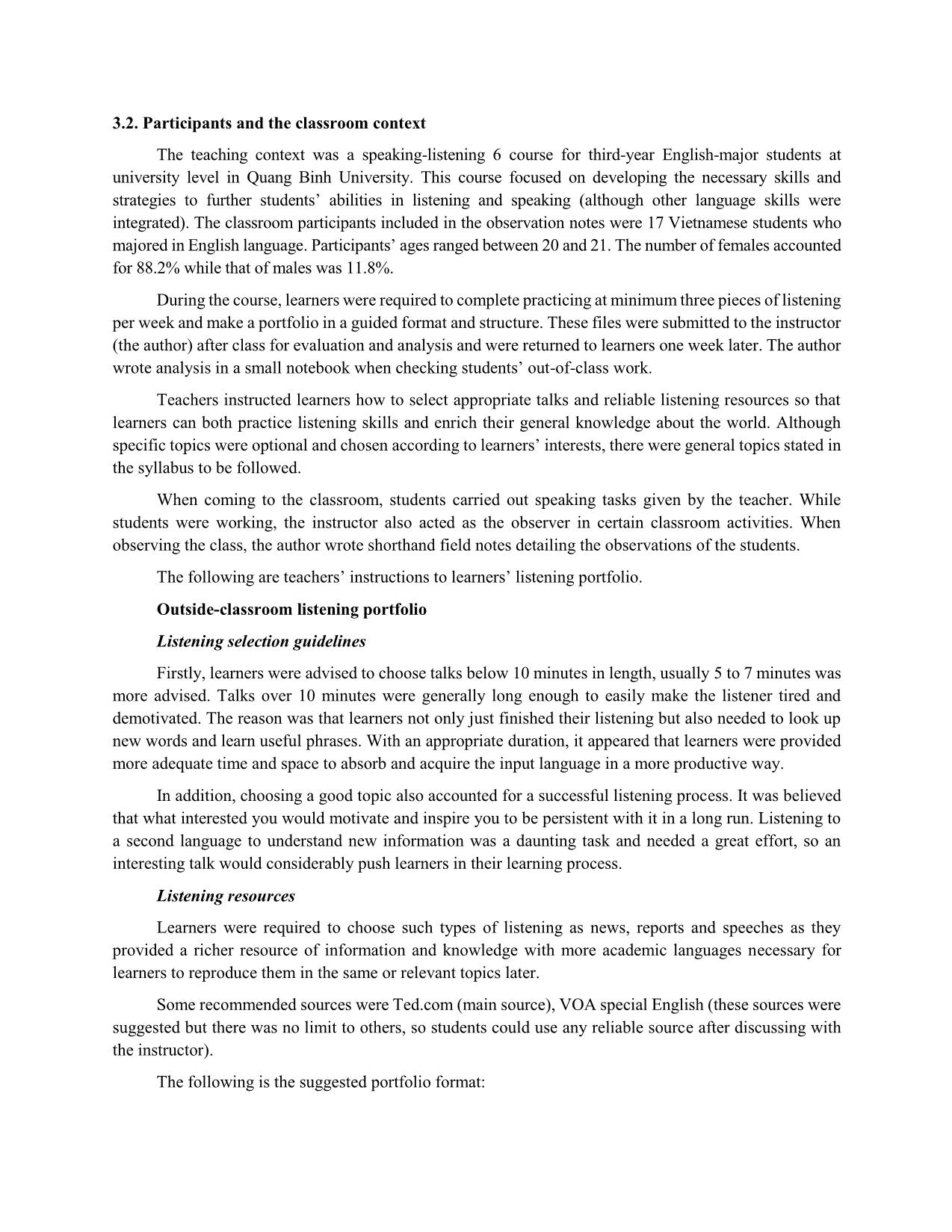
Trang 5
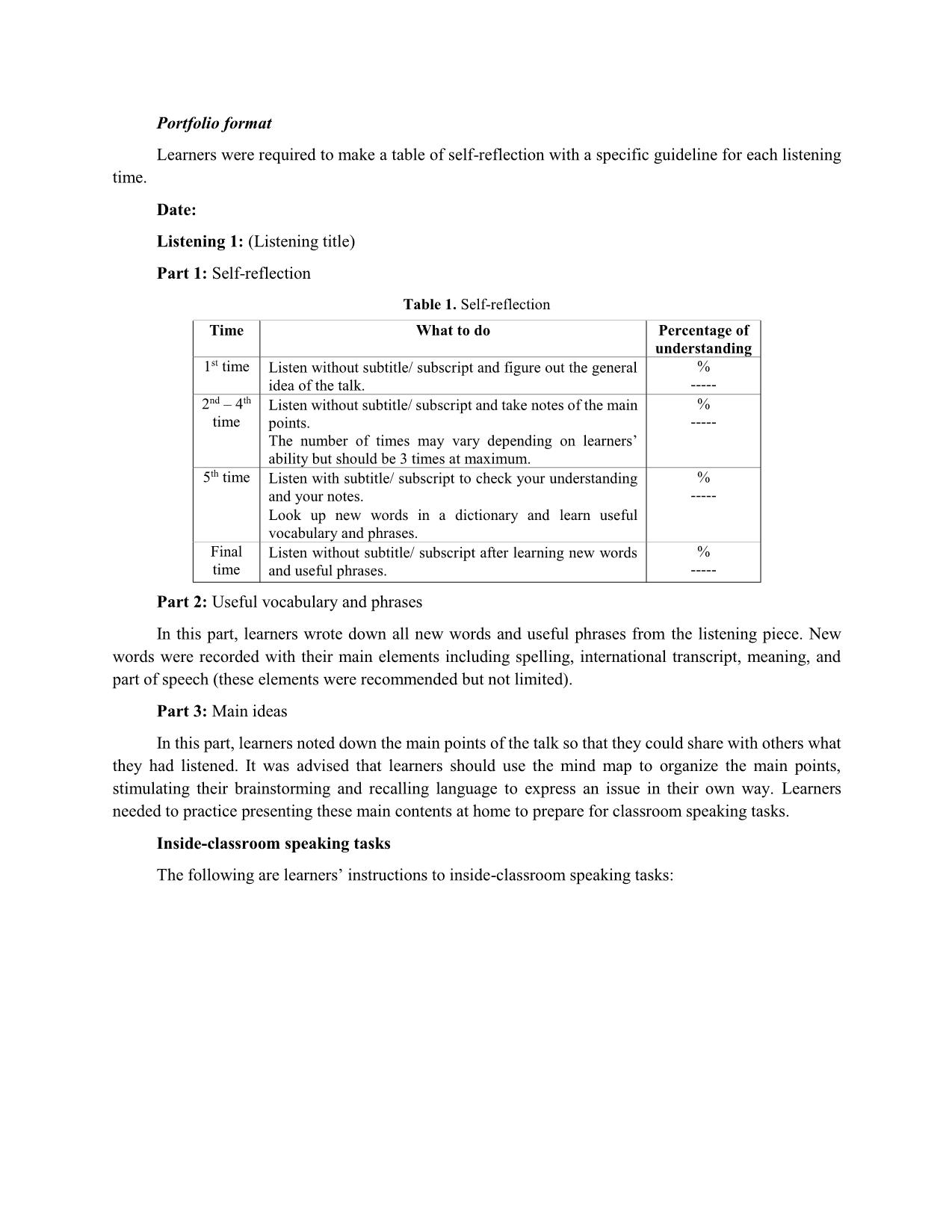
Trang 6
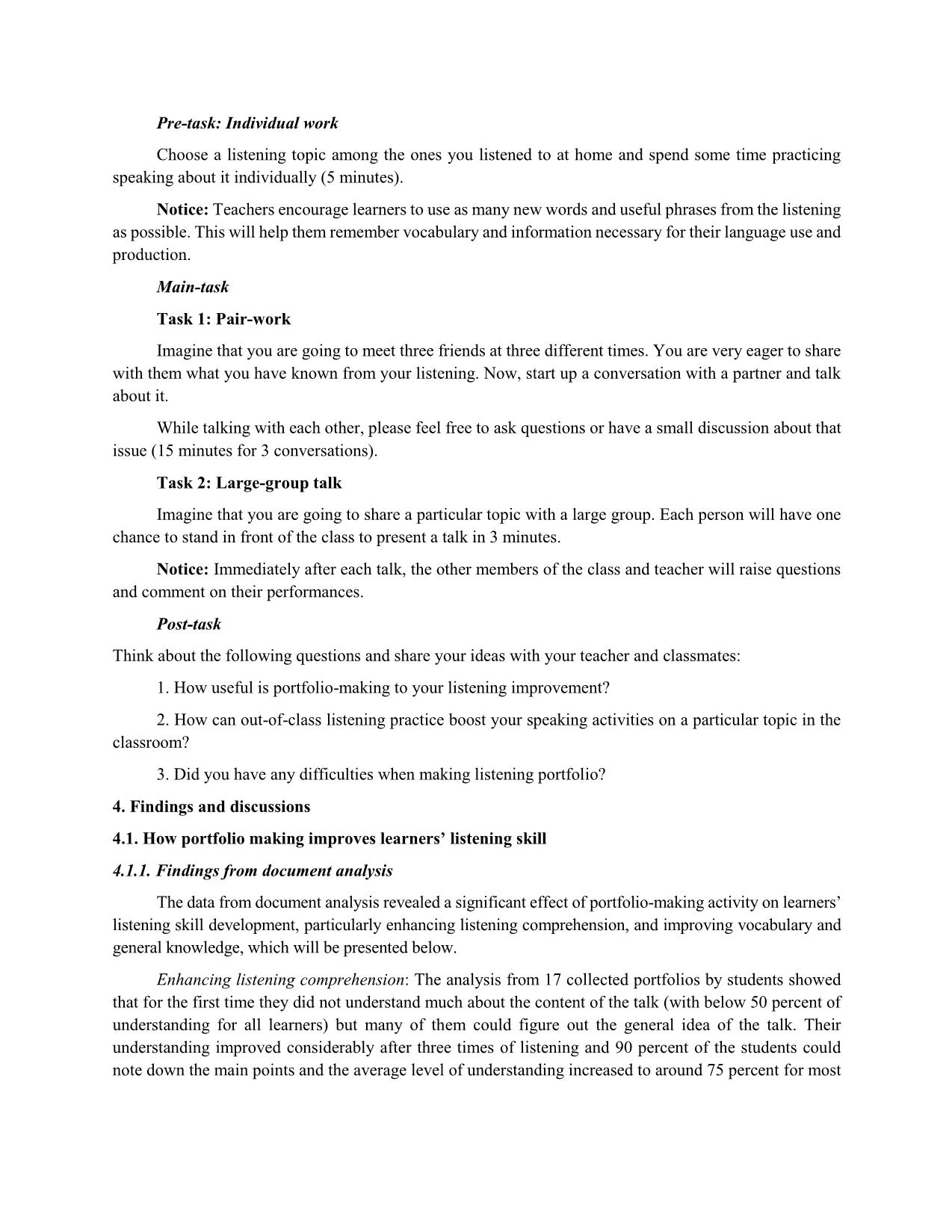
Trang 7
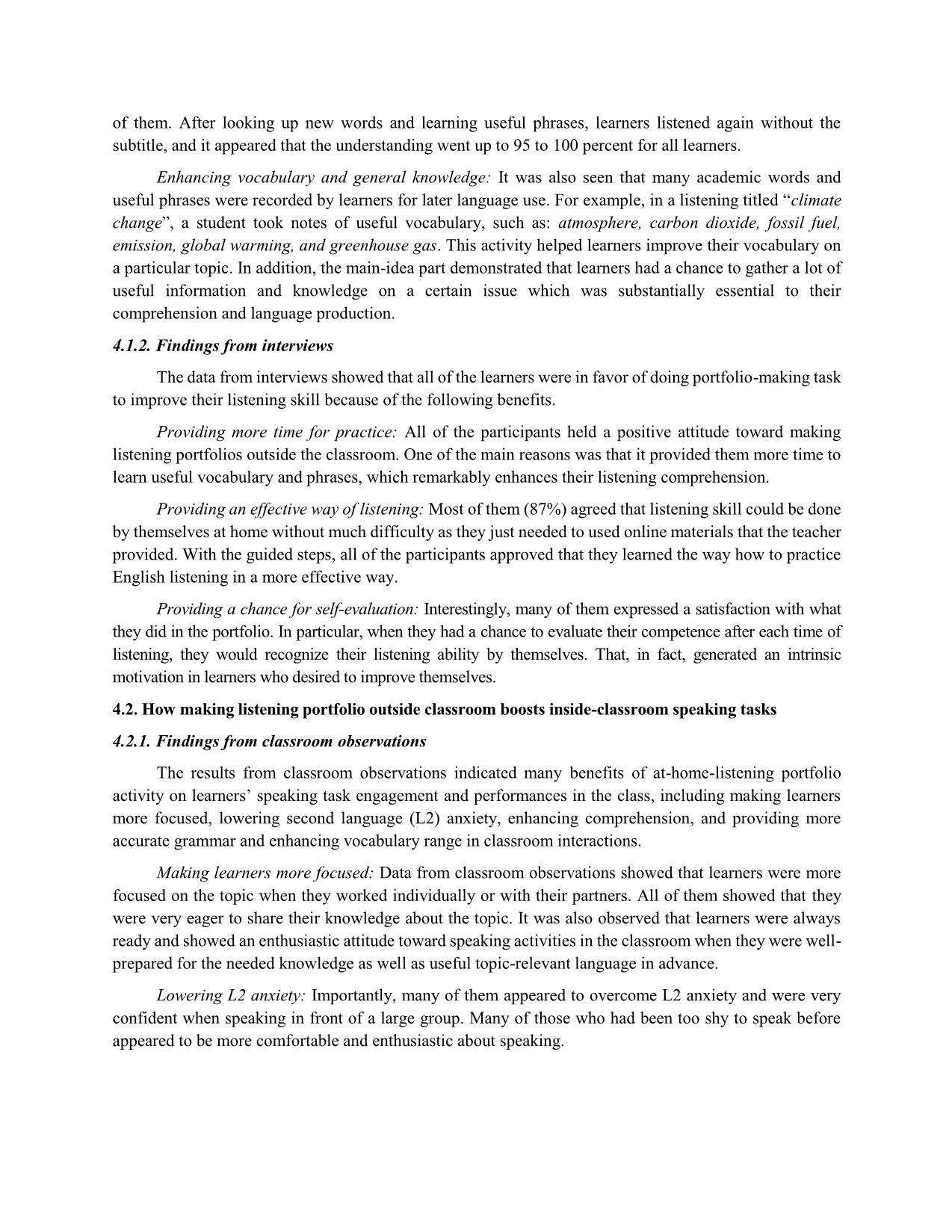
Trang 8
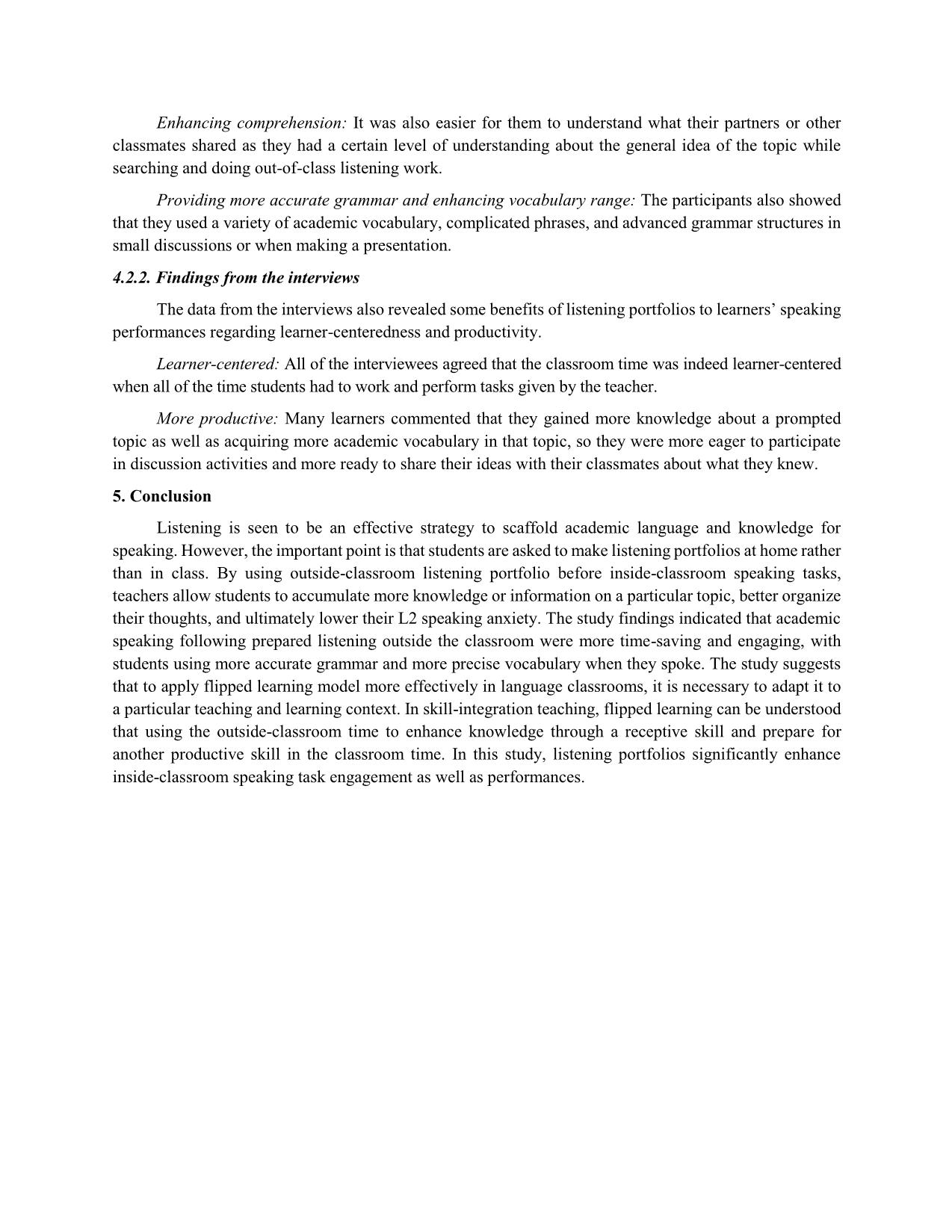
Trang 9
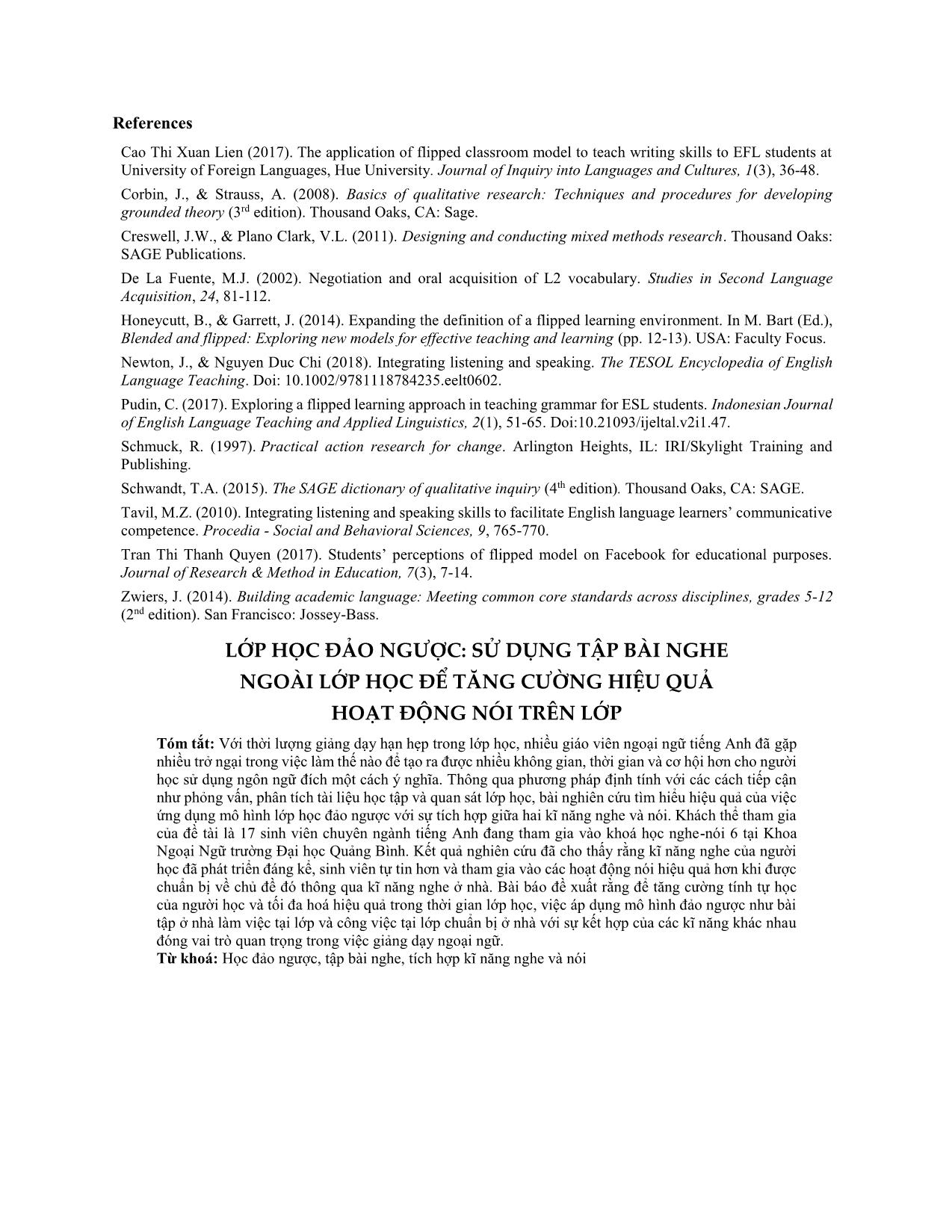
Trang 10
Tóm tắt nội dung tài liệu: Redefining a flipped learning classroom: Using outside-classroom listening portfolio to boost inside-classroom speaking tasks
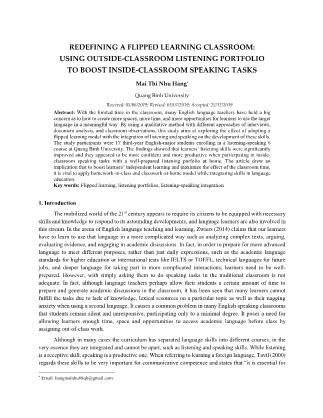
listening portfolio Listening selection guidelines Firstly, learners were advised to choose talks below 10 minutes in length, usually 5 to 7 minutes was more advised. Talks over 10 minutes were generally long enough to easily make the listener tired and demotivated. The reason was that learners not only just finished their listening but also needed to look up new words and learn useful phrases. With an appropriate duration, it appeared that learners were provided more adequate time and space to absorb and acquire the input language in a more productive way. In addition, choosing a good topic also accounted for a successful listening process. It was believed that what interested you would motivate and inspire you to be persistent with it in a long run. Listening to a second language to understand new information was a daunting task and needed a great effort, so an interesting talk would considerably push learners in their learning process. Listening resources Learners were required to choose such types of listening as news, reports and speeches as they provided a richer resource of information and knowledge with more academic languages necessary for learners to reproduce them in the same or relevant topics later. Some recommended sources were Ted.com (main source), VOA special English (these sources were suggested but there was no limit to others, so students could use any reliable source after discussing with the instructor). The following is the suggested portfolio format: Portfolio format Learners were required to make a table of self-reflection with a specific guideline for each listening time. Date: Listening 1: (Listening title) Part 1: Self-reflection Table 1. Self-reflection Time What to do Percentage of understanding 1st time Listen without subtitle/ subscript and figure out the general idea of the talk. % ----- 2nd – 4th time Listen without subtitle/ subscript and take notes of the main points. The number of times may vary depending on learners’ ability but should be 3 times at maximum. % ----- 5th time Listen with subtitle/ subscript to check your understanding and your notes. Look up new words in a dictionary and learn useful vocabulary and phrases. % ----- Final time Listen without subtitle/ subscript after learning new words and useful phrases. % ----- Part 2: Useful vocabulary and phrases In this part, learners wrote down all new words and useful phrases from the listening piece. New words were recorded with their main elements including spelling, international transcript, meaning, and part of speech (these elements were recommended but not limited). Part 3: Main ideas In this part, learners noted down the main points of the talk so that they could share with others what they had listened. It was advised that learners should use the mind map to organize the main points, stimulating their brainstorming and recalling language to express an issue in their own way. Learners needed to practice presenting these main contents at home to prepare for classroom speaking tasks. Inside-classroom speaking tasks The following are learners’ instructions to inside-classroom speaking tasks: Pre-task: Individual work Choose a listening topic among the ones you listened to at home and spend some time practicing speaking about it individually (5 minutes). Notice: Teachers encourage learners to use as many new words and useful phrases from the listening as possible. This will help them remember vocabulary and information necessary for their language use and production. Main-task Task 1: Pair-work Imagine that you are going to meet three friends at three different times. You are very eager to share with them what you have known from your listening. Now, start up a conversation with a partner and talk about it. While talking with each other, please feel free to ask questions or have a small discussion about that issue (15 minutes for 3 conversations). Task 2: Large-group talk Imagine that you are going to share a particular topic with a large group. Each person will have one chance to stand in front of the class to present a talk in 3 minutes. Notice: Immediately after each talk, the other members of the class and teacher will raise questions and comment on their performances. Post-task Think about the following questions and share your ideas with your teacher and classmates: 1. How useful is portfolio-making to your listening improvement? 2. How can out-of-class listening practice boost your speaking activities on a particular topic in the classroom? 3. Did you have any difficulties when making listening portfolio? 4. Findings and discussions 4.1. How portfolio making improves learners’ listening skill 4.1.1. Findings from document analysis The data from document analysis revealed a significant effect of portfolio-making activity on learners’ listening skill development, particularly enhancing listening comprehension, and improving vocabulary and general knowledge, which will be presented below. Enhancing listening comprehension: The analysis from 17 collected portfolios by students showed that for the first time they did not understand much about the content of the talk (with below 50 percent of understanding for all learners) but many of them could figure out the general idea of the talk. Their understanding improved considerably after three times of listening and 90 percent of the students could note down the main points and the average level of understanding increased to around 75 percent for most of them. After looking up new words and learning useful phrases, learners listened again without the subtitle, and it appeared that the understanding went up to 95 to 100 percent for all learners. Enhancing vocabulary and general knowledge: It was also seen that many academic words and useful phrases were recorded by learners for later language use. For example, in a listening titled “climate change”, a student took notes of useful vocabulary, such as: atmosphere, carbon dioxide, fossil fuel, emission, global warming, and greenhouse gas. This activity helped learners improve their vocabulary on a particular topic. In addition, the main-idea part demonstrated that learners had a chance to gather a lot of useful information and knowledge on a certain issue which was substantially essential to their comprehension and language production. 4.1.2. Findings from interviews The data from interviews showed that all of the learners were in favor of doing portfolio-making task to improve their listening skill because of the following benefits. Providing more time for practice: All of the participants held a positive attitude toward making listening portfolios outside the classroom. One of the main reasons was that it provided them more time to learn useful vocabulary and phrases, which remarkably enhances their listening comprehension. Providing an effective way of listening: Most of them (87%) agreed that listening skill could be done by themselves at home without much difficulty as they just needed to used online materials that the teacher provided. With the guided steps, all of the participants approved that they learned the way how to practice English listening in a more effective way. Providing a chance for self-evaluation: Interestingly, many of them expressed a satisfaction with what they did in the portfolio. In particular, when they had a chance to evaluate their competence after each time of listening, they would recognize their listening ability by themselves. That, in fact, generated an intrinsic motivation in learners who desired to improve themselves. 4.2. How making listening portfolio outside classroom boosts inside-classroom speaking tasks 4.2.1. Findings from classroom observations The results from classroom observations indicated many benefits of at-home-listening portfolio activity on learners’ speaking task engagement and performances in the class, including making learners more focused, lowering second language (L2) anxiety, enhancing comprehension, and providing more accurate grammar and enhancing vocabulary range in classroom interactions. Making learners more focused: Data from classroom observations showed that learners were more focused on the topic when they worked individually or with their partners. All of them showed that they were very eager to share their knowledge about the topic. It was also observed that learners were always ready and showed an enthusiastic attitude toward speaking activities in the classroom when they were well- prepared for the needed knowledge as well as useful topic-relevant language in advance. Lowering L2 anxiety: Importantly, many of them appeared to overcome L2 anxiety and were very confident when speaking in front of a large group. Many of those who had been too shy to speak before appeared to be more comfortable and enthusiastic about speaking. Enhancing comprehension: It was also easier for them to understand what their partners or other classmates shared as they had a certain level of understanding about the general idea of the topic while searching and doing out-of-class listening work. Providing more accurate grammar and enhancing vocabulary range: The participants also showed that they used a variety of academic vocabulary, complicated phrases, and advanced grammar structures in small discussions or when making a presentation. 4.2.2. Findings from the interviews The data from the interviews also revealed some benefits of listening portfolios to learners’ speaking performances regarding learner-centeredness and productivity. Learner-centered: All of the interviewees agreed that the classroom time was indeed learner-centered when all of the time students had to work and perform tasks given by the teacher. More productive: Many learners commented that they gained more knowledge about a prompted topic as well as acquiring more academic vocabulary in that topic, so they were more eager to participate in discussion activities and more ready to share their ideas with their classmates about what they knew. 5. Conclusion Listening is seen to be an effective strategy to scaffold academic language and knowledge for speaking. However, the important point is that students are asked to make listening portfolios at home rather than in class. By using outside-classroom listening portfolio before inside-classroom speaking tasks, teachers allow students to accumulate more knowledge or information on a particular topic, better organize their thoughts, and ultimately lower their L2 speaking anxiety. The study findings indicated that academic speaking following prepared listening outside the classroom were more time-saving and engaging, with students using more accurate grammar and more precise vocabulary when they spoke. The study suggests that to apply flipped learning model more effectively in language classrooms, it is necessary to adapt it to a particular teaching and learning context. In skill-integration teaching, flipped learning can be understood that using the outside-classroom time to enhance knowledge through a receptive skill and prepare for another productive skill in the classroom time. In this study, listening portfolios significantly enhance inside-classroom speaking task engagement as well as performances. References Cao Thi Xuan Lien (2017). The application of flipped classroom model to teach writing skills to EFL students at University of Foreign Languages, Hue University. Journal of Inquiry into Languages and Cultures, 1(3), 36-48. Corbin, J., & Strauss, A. (2008). Basics of qualitative research: Techniques and procedures for developing grounded theory (3rd edition). Thousand Oaks, CA: Sage. Creswell, J.W., & Plano Clark, V.L. (2011). Designing and conducting mixed methods research. Thousand Oaks: SAGE Publications. De La Fuente, M.J. (2002). Negotiation and oral acquisition of L2 vocabulary. Studies in Second Language Acquisition, 24, 81-112. Honeycutt, B., & Garrett, J. (2014). Expanding the definition of a flipped learning environment. In M. Bart (Ed.), Blended and flipped: Exploring new models for effective teaching and learning (pp. 12-13). USA: Faculty Focus. Newton, J., & Nguyen Duc Chi (2018). Integrating listening and speaking. The TESOL Encyclopedia of English Language Teaching. Doi: 10.1002/9781118784235.eelt0602. Pudin, C. (2017). Exploring a flipped learning approach in teaching grammar for ESL students. Indonesian Journal of English Language Teaching and Applied Linguistics, 2(1), 51-65. Doi:10.21093/ijeltal.v2i1.47. Schmuck, R. (1997). Practical action research for change. Arlington Heights, IL: IRI/Skylight Training and Publishing. Schwandt, T.A. (2015). The SAGE dictionary of qualitative inquiry (4th edition). Thousand Oaks, CA: SAGE. Tavil, M.Z. (2010). Integrating listening and speaking skills to facilitate English language learners’ communicative competence. Procedia - Social and Behavioral Sciences, 9, 765-770. Tran Thi Thanh Quyen (2017). Students’ perceptions of flipped model on Facebook for educational purposes. Journal of Research & Method in Education, 7(3), 7-14. Zwiers, J. (2014). Building academic language: Meeting common core standards across disciplines, grades 5-12 (2nd edition). San Francisco: Jossey-Bass. LỚP HỌC ĐẢO NGƯỢC: SỬ DỤNG TẬP BÀI NGHE NGOÀI LỚP HỌC ĐỂ TĂNG CƯỜNG HIỆU QUẢ HOẠT ĐỘNG NÓI TRÊN LỚP Tóm tắt: Với thời lượng giảng dạy hạn hẹp trong lớp học, nhiều giáo viên ngoại ngữ tiếng Anh đã gặp nhiều trở ngại trong việc làm thế nào để tạo ra được nhiều không gian, thời gian và cơ hội hơn cho người học sử dụng ngôn ngữ đích một cách ý nghĩa. Thông qua phương pháp định tính với các cách tiếp cận như phỏng vấn, phân tích tài liệu học tập và quan sát lớp học, bài nghiên cứu tìm hiểu hiệu quả của việc ứng dụng mô hình lớp học đảo ngược với sự tích hợp giữa hai kĩ năng nghe và nói. Khách thể tham gia của đề tài là 17 sinh viên chuyên ngành tiếng Anh đang tham gia vào khoá học nghe-nói 6 tại Khoa Ngoại Ngữ trường Đại học Quảng Bình. Kết quả nghiên cứu đã cho thấy rằng kĩ năng nghe của người học đã phát triển đáng kể, sinh viên tự tin hơn và tham gia vào các hoạt động nói hiệu quả hơn khi được chuẩn bị về chủ đề đó thông qua kĩ năng nghe ở nhà. Bài báo đề xuất rằng để tăng cường tính tự học của người học và tối đa hoá hiệu quả trong thời gian lớp học, việc áp dụng mô hình đảo ngược như bài tập ở nhà làm việc tại lớp và công việc tại lớp chuẩn bị ở nhà với sự kết hợp của các kĩ năng khác nhau đóng vai trò quan trọng trong việc giảng dạy ngoại ngữ. Từ khoá: Học đảo ngược, tập bài nghe, tích hợp kĩ năng nghe và nói
File đính kèm:
 redefining_a_flipped_learning_classroom_using_outside_classr.pdf
redefining_a_flipped_learning_classroom_using_outside_classr.pdf

